The Church of the Descent of the Holy Spirit
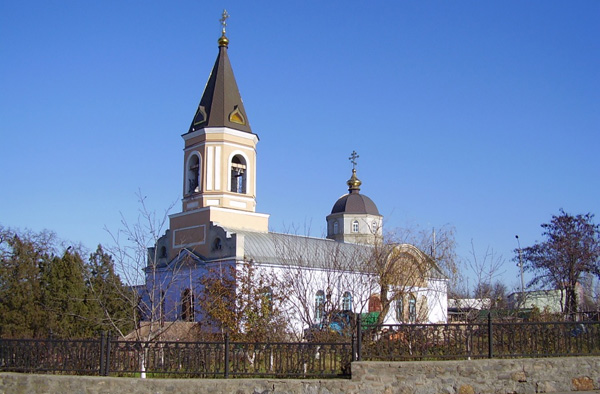
The church of the Holy Spirit in the 'Starom Vodoye' (Old Watering) district was consecrated on December 19 of 1857, the day of St. Nicholas Winter. The temple was built on the initiative of the people living in inhabitants of the settlement of Vodopoy, who by advice of Konstantin Sobolev asked the archbishop of Kherson and Tauride for permission to build it. A committee was assembled -at the request of Military Governor Moritz Berg -, that would oversee the construction. The architect Kazakov, adopted son of hereditary merchant Gabriel Dyumina, was appointed to build the church. The church was erected in the literal sense of 'the whole world'. Residents of the nearby settlements of Meshkovo, Shiroka Balka and Pogorelovo deposited money, quarried stone, burned lime, transported the building materials on their own carts, etc. The first rector of the Church of the Holy Spirit was the priest Sava Chekhovich. He was serving in the temple over forty years.
During the persecution of religion, the Holy Spirit church was closed and in 1936 was turned into a military warehouse. During the Great Patriotic War (World War II) services were being held in the church. In November 1962, the church was closed and used as a gymnasium and later as an urban memorial complex. Only in 1992 the church of the Descent of the Holy Spirit the faithful returned and its slow recovery began. The church is considered an architectural monument. (fotodni.com.ua)
Church of Saint Alexander Nevsky
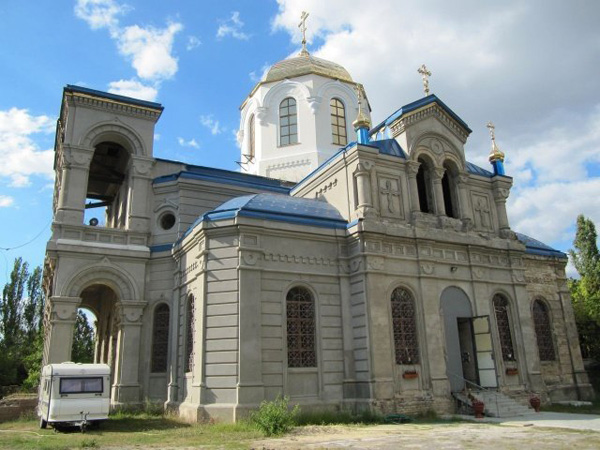
Church of St. Alexander Nevsky (or Hospital church), a Zhukovsky-Volyn project, was built in 1886 on the territory of the Nikolaev Naval Hospital financed by the War Department and by means of soldiers who fought in the Crimean War. The architect took society’s Slavic sentiment into account, so it is not by chance that the church was built in the strict Russian-Byzantine style. Located on the high bank of the Ingul river, the massive church has become an important part in the eastern skyline. It was here in this church, where the funerals were held of thousands of soldiers, killed during the war with Turkey for the liberation of the Balkan, and during the First World War.
Unfortunately, the Hospital church didn’t escape the events that unfolded during the 30s: the closing of churches. By request of the 15th Artillery Regiment, the Nikolaev City Council decided to close the church and turn it into a club. Church property and valuables were taken. During the German occupation, the temple was partially destroyed. After the war, it was used as a warehouse for some time and shortly after that it was simply abandoned.
With the advent of the new era, the former Church of St. Alexander Nevsky Orthodox community returned to the city. From an architectural monument of the XIX century, a dilapidated building without doors, without a roof and with gaping windows remained. Nevertheless, in spite of the irregular flow of funds, military forces and parishioners restored the Hospital Church. Although far from a full recovery, services are held weekly on Sundays and on feast days. ( )
Church of Saint Panteleimon
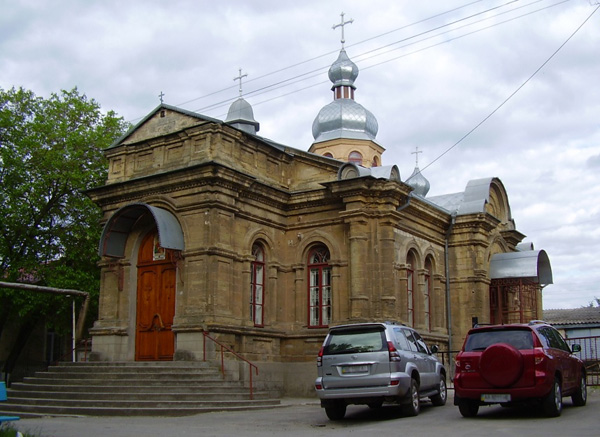
Church of Saint Panteleimon, on the territory of the city hospital, was built during the late 19th century, funded only by donations. In 1910, Feodosia Ilinichna Vignon, a wealthy widow of a Frenchman, donated 1,000 rubles for the construction of the Church of the Saints Leonid and Feodosia at the Nikolaev City Hospital. Six years later, end of 1916, she had spent over 14,000 rubles. Accordingly to her will, she was buried in a crypt under the Leonid-Fedoseevskaya church. After the October Revolution, the church was handed over to the hospital administration and has been used by medical staff club. After the 'Perestroika', during the first years of independence, the church was returned to the parish. The church is now dedicated to Saint Panteleimon. ( )
Saint Michael’s Church
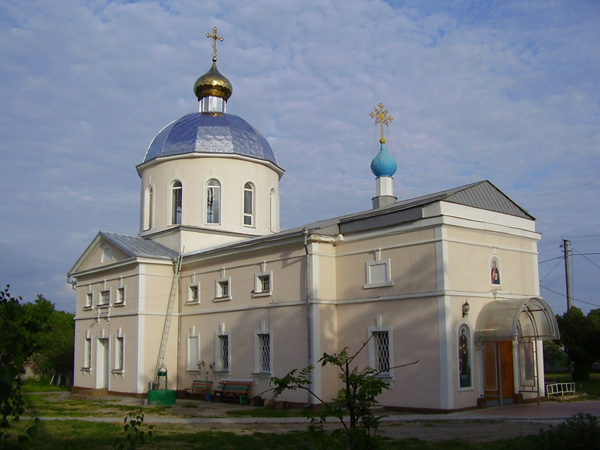
In the village of Varvarovka on the right bank of the Bug river delta (now a small district in Nikolaev), construction was completed in 1811 and the Saint Michael’s church was consecrated. Closeby was a parochial school was set up. The church was closed in 1936, and served as a warehouse. Religious valuebles and icons were partly taken and partly destroyed. During World War II, the Romanian invaders used the church as a camp for prisoners of war. In 1950, the parishioners renovated Saint Michael’s church and services were being held again. In the new millennium a bell tower was added. ( )
Church of the Assumption of the Blessed Virgin
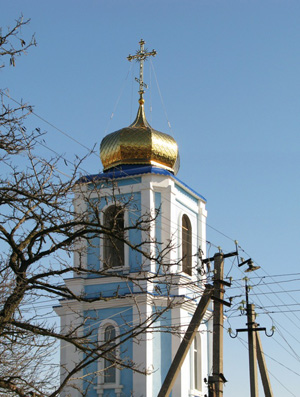
The Church of the Assumption of the Blessed Virgin in Ternovka (Nikolaev district), was originally a Muslim mosque. Construction of the mosque was supervised by military architect Ivan Knyazev, by orders of the Chief Commander of the Black Sea Fleet, Admiral Nikolai Mordvinova. Only after the Turks were evicted from Ternovka, the mosque was rebuilt into an Orthodox Church. Before the beginning of the 20th century two minarets stood on the territory of the church. Now, nothing remains of its Muslim past. With the coming of Soviet power, the Assumption church was closed and converted into a club. After World War II, the Village House of Culture was housed in the church building. Since 1994, the church acts again as a temple of God. ( )
The Church of Reverend Sergey Radonezh
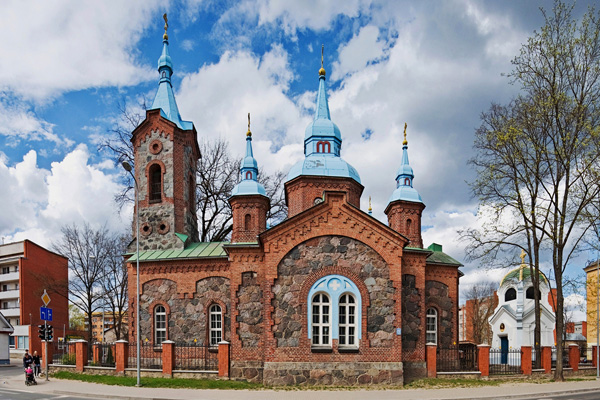
In the last years of the 20th centruy, there was the idea of building a church in honor of the Russian Orthodox reverend Sergey Radonezh in the city of Nikolaev. The head of the Orthodox Church in the Nikolaev region consecrated a place in a square on Vaslyaeva street for the future church. For a long time, while the church was being built, service was being held in a railroad boxcar. Next to it was a wooden cross in commemoration of the 2000th anniversary of the birth of Christ. Now, services are being held in the new wooden temple. The Church of Reverend Sergey Radonezh is constructed in the classical Russian style. ( )
Church of Saint John the Warrior
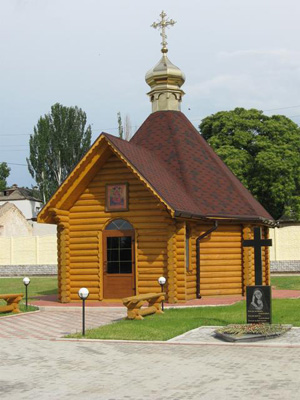
In 2011, the Orthodox Church of St. John the Warrior was consecrated. This church is also a monument dedicated to the AMIA employees who were killed in the line of duty during the first years of Ukrainian independence. Built from wood, the temple is situated on the territory of Nikolaev Regional Forensic Center. Next to the temple stands an obelisk in the shape of a cross with the face of the Virgin. The small, modest, but at the same time elegant church is not only an ornament of the district, but also of the city. ( )
Church of St. Catherine
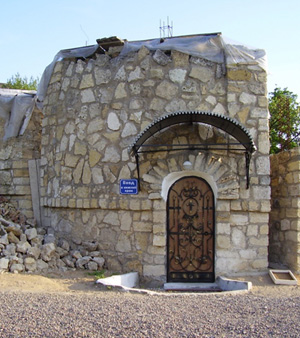
For a couple of years now, the church of Saint Catherine is being built. It is a church-monument dedicated to the outstanding young pianist Ekaterina Panna. At age of four, she discovered her ability to play the piano. Her gift developed over the next ten years. During her short life, Kate was the winner of several international competitions. Who knows what might have been, if in 1999 that terrible car accident didn’t happen. The initiator of the construction of the church in the name of Saint Catherine is the girl's father, Alex Panna. Under the church is a crypt. There is a Sunday school at the church. The church is still far from finished due to lack of funds. However, this church is one of the most well-known and most visited in the city. ( )
Chapel of Our Lady of the Healer
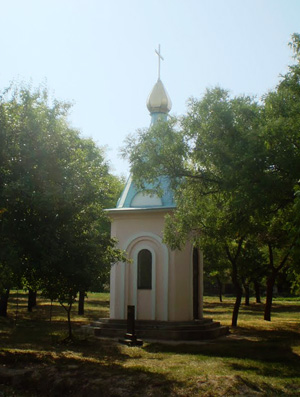
Chapel of Our Lady of the Healer was erected in a park in the historic center of Nikolaev. The small chapel can accommodate just one person. Inside the chapel is a sculpture of Our Lady. Opposite of the chapel, in the shadow of some trees, is a bench and a low black obelisk with the inscription: "Hail, Hail grace, the Lord is with thee; blessed art thou amongst women and blessed is the fruit of thy womb, for thou borne the Saviour of our souls." After these words in the right corner, it says: "Thank the Blessed Virgin Mary for healing. Amen." ( )
Nicholas Church in Nikolaev
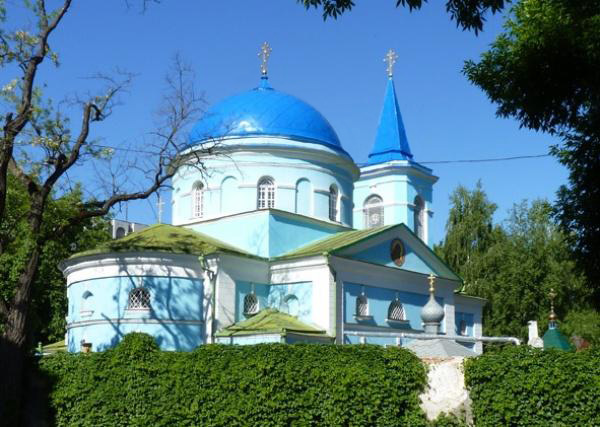
The first attempt to build a church in honor of St. Nicholas was done in the late 18th century. On the 26th of June 1769, G.A. Potemkin sent Catherine II a request for constructing the Saint Nicholas Monastery for monks and the disabled; veterans of the war with the Turks, in the area of 'Vitovka' (now the Korabelhy district), near the Ingul river. Resolution came immediately. The abbot of the not yet built monastery was Archimandrite Moses. But due to the death of the prince, the decision about founding the monastery wasn’t made.
On December 17 1789, a year after the capture of Ochakov, M.L. Faleev informed the Archbishop of Ekaterinoslav, Kherson and Tauride Ambrose (Serebrennikov) about his intentions to build the church in honor of St. Nicholas in Nikolaev. In 1790, the wooden Greek church in honor of St. Nicholas was built (at the intersection of present-day Pushkin and Potemkin streets). It existed for about 20 years. A description nor image have been preserved. The stone Greek St. Nicholas Church (now the St. Nicholas Cathedral) was built from 1803 to 1817. Quite a long time constructing a relatively small temple. This was primarily due to lack of funds. Since its consecration in 1817, the temple has never been closed for a long time. Even during the 20s and 30s of the twentieth century, services continued. When Nikolaev became the diocesan center, the St Nicholas Church was given the status of 'cathedral'. The temple was restored and a bell was installed in the bell tower. The cathedral is listed as an architectural monument of national importance. (nikolaev.glo.ua)
Church of St. George
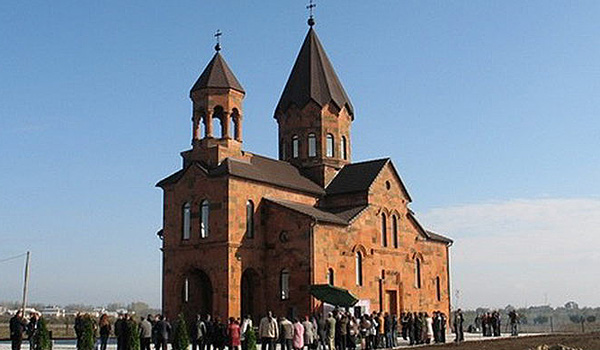
In 2011, the church of St. George, the Armenian Apostolic Church with a cross on its main dome, was consecrated. The Armenian community in Nikolaev is one of the largest in the region. The church of St. George was built on an empty site at the main road between two neighborhoods in Nikolaev (Shirokaya Banka and Oktoberskoye in the 'Korabel' district. Building took place in 2008. However, due to the global financial crisis, only in 2010 there were enough funds for completing construction. In the future next to the temple, they plan to build a house of Armenian culture. The church was built by the famous architect Vadim Pavlovich Popov. The church is built in the same style as early Christian churches. The cladding is volcanic tuff, specially brought from Armenia. The temple has a ground floor, which serves as a hall for meetings of the Armenian community.
Synagogue
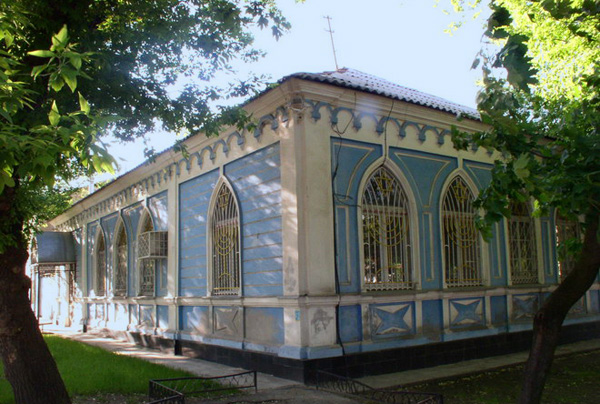
The synagogue was built and consecrated in 1822 on Chernigov Street. The synagogue functioned not only as a house of prayer, but also as a school. Years later, the decision was made to build a new large synagogue. The construction site was chosen at Bolshaya Morskaya Street and Faleevska Street. In 1884, it was opened and solemnly consecrated as the New Choral Synagogue.
During the persecution of religion, all the prayer houses were closed or destroyed. The Old Synagogue on Chernigov Street was converted to a Polish workers' club, then a club for medical staff. The Choral Synagogue was closed in 1829 and used for work on "Hebrew" language, then as a police club. During World War II, the Choral Synagogue was blasted by the invaders in 1944 and now this is a residential neighborhood.
When in Ukraine freedom of religion had been proclaimed and believers began to return, the new main synagogue began its work in the former house of 'Beit Midrash' at Karl Liebknecht Street. To date, this architectural monument is in a bad and dangerous condition. It is closed and still showing traces of its 'club' history.
Peter and Paul Church in Zhovtnevoe
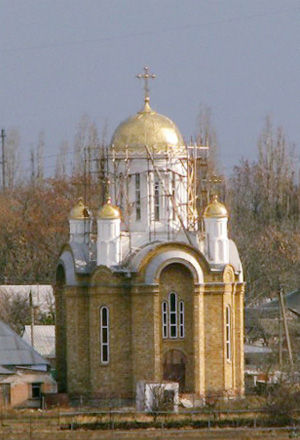
In the Korabel district, in the part that used to be the village of Bogoyavlensky (now Zhovtnevoe) the construction of the Church of the Holy Apostles Peter and Paul has been going on for several years. The church has already acquired its appearance and now work on the interior decoration and exterior finishing is done. The Peter and Paul Church is located at Ternopilskoy Street in the district of Balobanovky. It is said that the place where the church is being built and where people wil pray has a high level of positive energy.
All Saints Church

The All Saints Church was built in 1807-1808. In 1858, financed by the former churchwarden and the merchant guild Sobolev it was rebuilt and expanded. In 1876, an iron fence was put around the premises by of the merchant guild Bartenev, with the assistance of the former chief commander of the Black Sea fleet, Adjutant General Nikolay Arkas. In the same year, in the churchyard a two-story chapel for funerals was constructed. The church is one with two thrones: in the name of all the saints, and in the name of St. John the Theologian.
Kasperovsky Cathedral
Our Lady Cathedral (the Orthodox Cathedral in Nikolaev) belongs to the Ukrainian Orthodox Church Kiev Patriarchate. The temple is dedicated to one of the most revered miracle-working icons. The Kasperovsky icon 'the Mother of God', that came to Nikolaev every year from 1853 to 1918 and for a month (July) went from church to church. Residents believed that this icon saved the city from enemy attack during the Crimean War (1853-1856). In 1855, the Dean of the diocesan churches in Nikolaev, archpriest Ivan Stanislavsky, gave the military governor of Nikolaev, M.B. Berchem a petition: "... in gratitude of Nikolaev’s salvation from the enemy to build a temple in the name of the All-Merciful Saviour with two chapels in the name of the Holy Virgin Kasperovskaya in the south-eastern part of the city."
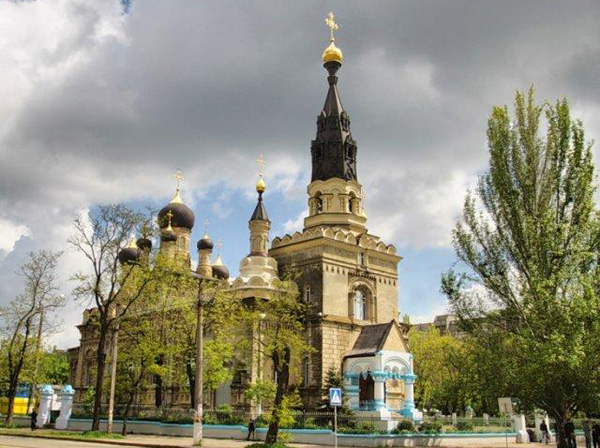
On June 1st, Berchem ordered the City Council to select a location for the cathedral and allow for raising money for construction. The architect professor Fyodor Ivanovich Eppinger was asked for designing the cathedral. Eppinger was a student of the famous architect Konstatin Tona, who built the Christ the Savior Church in Moscow.
The project soon was presented to the Board of Trustees. It was approved and also the Kherson Spiritual Consistory gave permission. Fundraising went slowly, so in 1872 the City Council donated a part of the territory. But construction still didn’t start. According to historian D.I. Zakovovorotnygo the delay was caused by the construction of many churches in that period. There just wasn’t enough money. In 1880, the Kasperovsky House of Prayer was built on the site.
The ceremonial laying of the cathedral’s icon 'the Mother of God' took place in May 1904. Construction management was entrusted to architect E.A. Shtukenberg, construction work to D.I. Gavrilov. With a budget of 40,000 rubles, construction progressed fairly quickly. After erecting the walls the money was spent and construction came to a halt. The City Council granted another 15,000 rubles, in the form of a loan that should be paid back in15 years. In 1908, when construction was nearly completed, again they ran out of money. The City Council this time donated 8,000 rubles so the cathedral could be completed. On the 28th of December 1908, the cathedral was consecrated, but the finishing touches continued for some years still.
In 1922, the cathedral fell victim to the anti-religion campaign. In February 1930, the bell tower bells were removed and sent to a factory 'for the needs of the country' in the ensuing industrialization. In October 1934, by decision of the Odessa Regional Executive Committee (Nikolaev at that time was part of the Odessa region), the Kasperovsky Cathedral of the Icon 'the Mother of God' was closed. The building was at the disposal of Nikolaev City Council, that gave it to a shipyard company. The new owners demolished the upper part of the bell tower and destroyed the dome. The building escaped complete destruction, in order to make place for a new plant, because of lack of funding. In this distorted state the building stood for 58 years.
During the Great Patriotic War (the German occupation) worship was restored in the cathedral, but only until 1949. In 1992, the cathedral was transferred back to the Ukrainian Orthodox Church of Kiev Patriarchate. Services resumed, and reconstruction started. By 2010, the original appearance of the cathedral was almost completely restored. (nikolaev.glo.ua)
Cathedral of the Nativity of the Virgin in Nikolaev
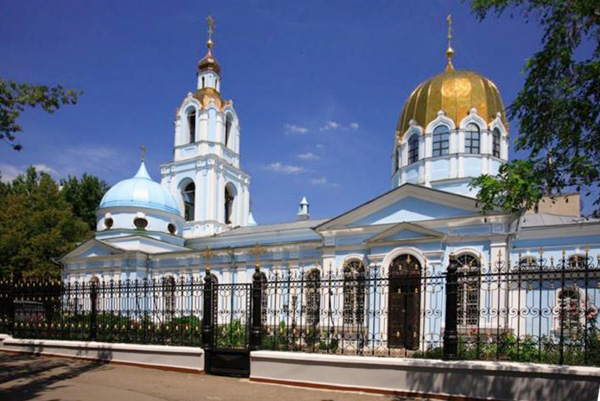
The Cathedral of the Nativity of the Virgin is oldest temple in Nikolaev. It was built, paid for by donations of Nicholaev merchants in 1800. It is located in the historic centre of the city. In 1828, two chapels were attached. In 1874, a parochial trusteeship was founded, where archpriest John Sergiev - prior of the Kronstadt cathedral - was an honorary member, also know as Saint John of Kronstadt. In 1876, a huge bell was installed in the bell tower, weighing over 8 tons. In 1922, when church property was seized, 172 kilograms of silver was taken in order to feed the hungry. On the 31st of January 1930, the government took the bell from the bell tower and six years later, in 1936, the cathedral was closed. After reconstruction, the building was converted into an officer’s mess, which saved the cathedral from total destruction. In 1992, the cathedral was returned to the religious community. (nikolaev.glo.ua)
Church of St. Joseph
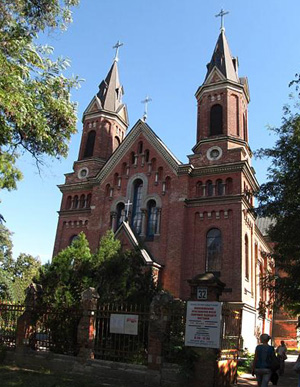
The church of St. Joseph is located at the Decembrists’ (Dekabristov) Street. This catholic church was built in 1896 and financed by the local catholic parish. Dombrovsky was the architect. The church was closed by the Soviet authorities in 1934. After this, spiritual life in the church stopped for many years. Only in 1992, believers could return to the church.
On the church’s territory in the neighboring building is the Regional Museum of Local History. The church was built with red brick in the eclectic style, that is typical for the Odessa architect V. Dombrowsky. The building measures 45 by 28 meters, the two towers are 49 meters tall. Under Soviet rule, the church was closed. In 1991 it was reopened. In 2005, the church received a gift: a German-made organ. Not a new one, but in very good order. The organ was produces in 1950 and has 28 registers, two keyboards and foot pedals. Currently, the Roman-Catholic church of St. Joseph is open and restorations continue. On holidays, organ concerts are performed by famous organists from all of Europe. (nikolaev.glo.ua)
St. Nicholas Chapel
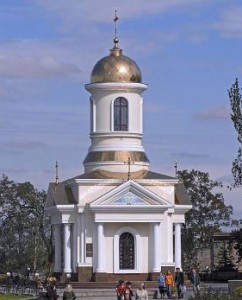
In 2004, on Lenin Square the chapel of St. Nicholas was built. The idea was to build it in honor of the patron saint of the city, St. Nicholas. The chapel is owned by entrepreneur Mr. Zhiltsova. After erecting the walls, further construction had been suspended due to financial difficulties. In 2007, another entrepreneur, I. Danishevsky, received the blessing of the Archbishop Pitirim, and he continued construction. But it already was not a chapel, but a temple, a place of worship. A new architectural plan was made and two previous walls were demolished, a porch was built and the altar was made bigger. The cross is gilded with gold leaf and the dome is covered with titanium nitrite, popularly called 'blue-golden light'. Experts worked on the dome for about two years. A year later, in March, the dome and the cross were hoisted into place with a special crane, lifting them 18 meters high.
During construction, the idea came to use colorful glass-stained windows. On three sides of the church the glass-stained windows depict scenes form St. Nicholas’ life. The iconostatis took about a year to build and install. Three colours of marble from Greece and Spain were used. A wonderful archirtectural decision was to make statues of the Archangels Gabriel, Michael, Uriel and Raphael, decorating the four sides ot the church. (nikolaev.glo.ua)
Peter and Paul Church in Stepovye
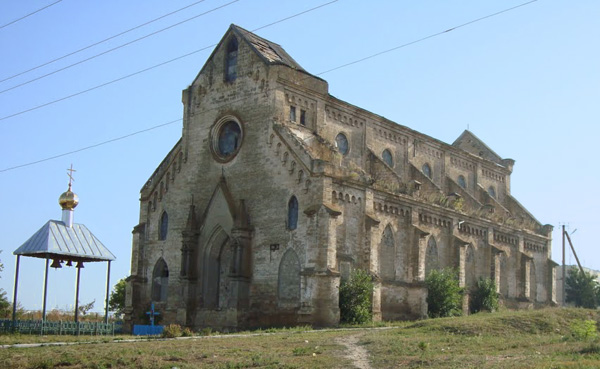
The church of St. Peter and Paul is the most beautiful preserved old catholic church, located near Odessa. Built in 1881-1885, it was designed by architect Korf. The church was neglected and gradually fell apart. No roof, windows sealed. Inside a part of the wall paintings is still preserved. (nikolaev.glo.ua)
BANDS AND SINGERS
Okean Elzy
Jamala
The Hardkiss
Tina Karol
Christina Solovy
Piccardysky Tertsiya
advertisement
Ruslana
Skryabin
Alyosha
Olexander Ponomarev
Zlata Ognevich
Onuka
advertisement
Antityla
Loboda
Irina Dumanskaya
Irina Fedishin
Vivienne Mort
Krykhitka Tsakhes
advertisement
S.K.A.Y.
Druha Rika
Boombox
Buv'ye
Lama
Platch Yeremy
advertisement
Voply Vidoplasova
T.N.M.K.
Tartak
Noomer 482
Braty Hadukyny
O. Torvald
advertisement
Bahroma
Epolets
Haidamaky
TIK
Ani Lorak






